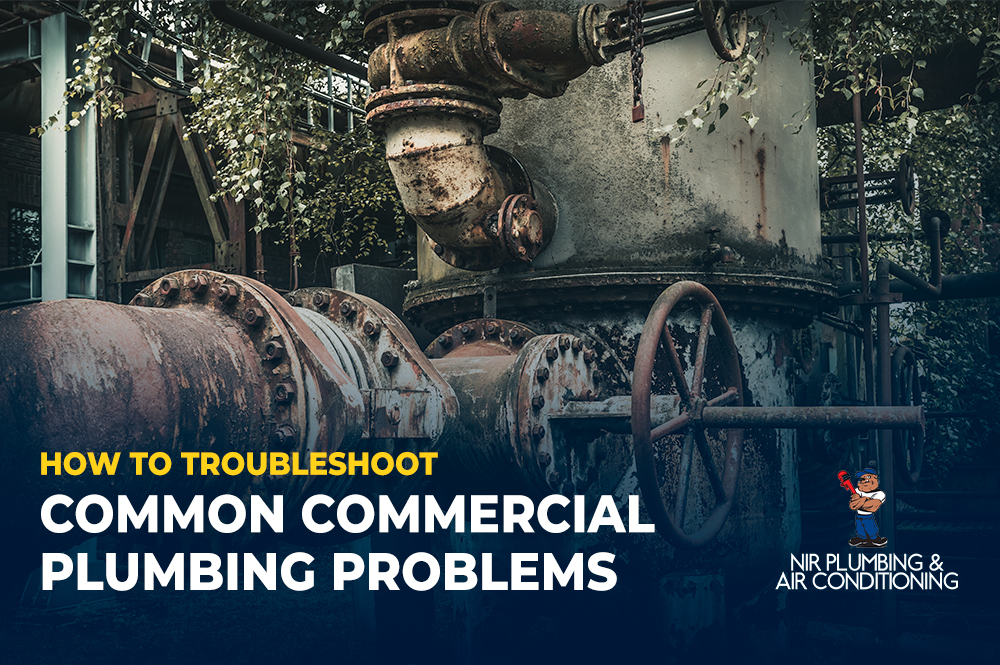Overview: Running a business can be stressful, especially when it comes to plumbing issues. But some of the most frequently-encountered problems can be resolved DIY style. Check out this guide to troubleshooting common commercial plumbing problems.
Is your break room sink draining slower than a turtle race? Are mysterious leaks turning your office into a mini-water park? Or is a constant dripping driving you up the wall? When you have plumbing problems at your company, you’re going to want to fix them quickly so you can get back to business as usual.
Commercial plumbing systems are vital for the smooth operation of businesses and establishments. However, plumbing issues can arise unexpectedly, causing inconvenience and potentially disrupting operations. Being able to troubleshoot and resolve common plumbing problems can save you time, money, and stress.
In this blog post, we’ll discuss some of the most common commercial plumbing problems and provide practical troubleshooting tips to help you resolve them effectively.
Clogged Drains
Clogged drains are a frequent plumbing issue in commercial settings due to the heavy usage that drains get. To troubleshoot this problem, start by using a plunger to attempt to dislodge the blockage. If the plunger doesn’t work, try utilizing a plumbing snake or auger to remove the obstruction manually.
As a preventive measure to stave off future clogs, encourage employees to avoid washing inappropriate materials down your drains and schedule regular drain cleanings to minimize the risk of clogs.
>>> Related Reading: Everything You Need to Know About Plungers
Leaking Faucets
Leaky faucets not only waste water but also contribute to increased water bills. To troubleshoot this issue, check the faucet’s washer, O-ring, or cartridge for wear and tear. If necessary, replace the damaged component — but don’t forget to shut off the water first!
It’s also essential to inspect your pipe connections and tighten them if they are loose. In cases of severe leaks, it’s advisable to call a professional plumber to prevent further damage.
Running Toilets
A running toilet can waste a significant amount of water and lead to high water bills. To troubleshoot this problem, remove the toilet tank lid and inspect the flapper valve. Ensure it forms a tight seal when the toilet is not in use. Adjust or replace the flapper if needed.
Additionally, check the fill valve and adjust the water level to the appropriate mark on the overflow tube. If the issue persists, consult a plumber to identify and resolve any underlying problems.
>>> Related Reading: 3 Reasons Why Your Toilet Keeps Running
Low Water Pressure
Low water pressure can hamper daily operations and affect employee productivity. To troubleshoot this issue, check the pressure-reducing valve (PRV) to ensure it is set correctly. If it’s already adjusted correctly, examine the aerators in faucets and showerheads for mineral deposits or debris buildup.
Cleaning or replacing aerators can often restore normal water pressure. If the problem persists, it may be necessary to consult a professional to investigate potential pipe blockages or other underlying causes.
Here’s a guide on What is Pressure-Reducing Valve, its types, application, and advantages
Addressing Sewer Line Blockages
You might overlook sewer line blockage, but it can lead to unpleasant backups and potential health hazards — if neglected.
Follow these steps to tackle sewer line issues:
Use a Sewer Snake: A sewer snake, also known as an auger, is an effective tool to break through blockages in sewer lines. Insert the snake into the clean-out and push it through the line until the obstruction clears.
Hydro Jetting: Consider hiring a professional plumber for hydro jetting, a high-pressure water jetting method that clears tough clogs and removes buildup from sewer lines.
Perform a Sewer Camera Inspection: Sewer camera inspection is a cutting-edge technology that revolutionizes the way plumbing issues are diagnosed and resolved in commercial buildings. This non-invasive method involves inserting a high-resolution camera into the sewer line to capture real-time video footage of its interior.
By utilizing this advanced technology, plumbers can accurately identify blockages, leaks, and other issues that may be hidden underground or within the pipes.
Preventive Measures: Regularly schedule sewer line inspections to detect potential issues early on. Additionally, educate employees about what should and shouldn’t be flushed down the toilets to prevent blockages.
Water Heater Problems
Water heater issues can disrupt various commercial activities, particularly at businesses reliant on hot water, such as restaurants or hotels. If a water heater is not producing hot water or if there are temperature fluctuations, start by checking the thermostat settings and adjusting them as needed.
Inspect the heating elements for any signs of damage or corrosion. Flushing the tank to remove sediment buildup can also improve its efficiency. However, for complex issues or if gas-related problems are suspected, it is best to call a licensed plumber.
In Summary
By understanding and implementing these troubleshooting tips, you can address common plumbing problems in your commercial establishment promptly. Remember, preventive maintenance is key to reducing the occurrence of plumbing issues.
Regularly inspecting and maintaining your plumbing system, as well as promoting responsible usage among employees, can go a long way in minimizing disruptions and ensuring the smooth operation of your business.
However, if you encounter more complex or persistent plumbing problems, it is always advisable to seek professional assistance. Our team at NIR Plumbing is standing by to help you prevent damage to your plumbing system and ensure long-lasting solutions!


